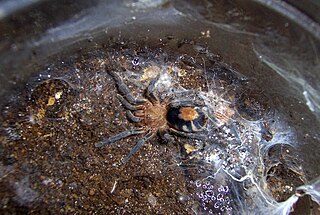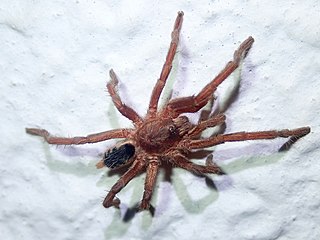
Avicularia is a genus of the family Theraphosidae containing various species of arboreal tarantulas. The genus is native to tropical Central and South America. Each species in the genus has very distinguishable pink foot pads.

Dolichothele is a genus of spiders in the family Theraphosidae found in Brazil and Bolivia. It was first described in 1923 by Mello-Leitão. As of 2017, it contains 8 species.

Pamphobeteus is a genus of tarantulas that was first described by Reginald Innes Pocock in 1901. It includes some of the largest spiders in the world.

Tarantulas comprise a group of large and often hairy spiders of the family Theraphosidae. Currently, 1,010 species have been identified. The term "tarantula" is usually used to describe members of the family Theraphosidae, although many other members of the same infraorder (Mygalomorphae) are commonly referred to as "tarantulas" or "false tarantulas". Some of the more common species have become popular in the exotic pet trade. Many New World species kept as pets have setae known as urticating hairs that can cause irritation to the skin, and in extreme cases, cause damage to the eyes.

Cyriocosmus is a genus of tarantulas that was first described by Eugène Louis Simon in 1903.

Ephebopus is a genus of northeastern South American tarantulas that was first described by Eugène Louis Simon in 1892. Its relation to other tarantulas is one of the most uncertain in the family, and it has been frequently moved around and has been placed in each of the eight subfamilies at least once.

Acanthoscurria is a genus of tarantulas that was first described by Anton Ausserer in 1871.
Sickius is a genus of tarantulas. It has a single species, Sickius longibulbi. It is endemic to Brazil.
Kochiana is a monotypic genus of Brazilian tarantulas containing the single species, Kochiana brunnipes or the dwarf pink leg. It was first described by C. L. Koch in 1841 under the name "Mygale brunnipes", and was transferred to its own genus in 2008. As of April 2020, it has only been found in Brazil.

Pterinopelma is a genus of Brazilian tarantulas that was first described by Reginald Innes Pocock in 1901. As of May 2020 it contains three species, found in Brazil: P. felipeleitei, P. sazimai, and P. vitiosum. It was removed from the synonymy of Eupalaestrus in 2011.
Stenoterommata is a genus of South American araneomorph spiders in the family Pycnothelidae. It was first described by E. L. Holmberg in 1881. Originally placed withe the Ctenizidae, it was transferred to the funnel-web trapdoor spiders in 1985, then to the Pycnothelidae in 2020. It is a senior synonym of Ctenochelus.
Tmesiphantes is a genus of Brazilian tarantulas in the subfamily Theraphosinae that was first described by Eugène Louis Simon in 1892. The genera Magulla and Melloleitaoina were brought into synonymy in 2019.
Trichopelma is a genus of South American and Caribbean tarantulas first described by Eugène Simon in 1888.

Fufius is a genus of Central and South American wafer trapdoor spiders that was first described by Eugène Simon in 1888. Originally placed with the curtain web spiders, it was moved to the Cyrtaucheniidae in 1941.
Schismatothele is a genus of South American tarantulas that was first described by Ferdinand Anton Franz Karsch in 1879.

Ybyrapora is a genus of spiders in the family Theraphosidae (tarantulas), found in Brazil. Its species were formerly placed in the genus Avicularia.

Avicularia variegata is a species of spider in the family Theraphosidae found in Venezuela and Brazil. Previously described as Avicularia avicularia variegata, it is synonymous with Avicularia bicegoi.

Guyruita cerrado is a species of spider in the genus Guyruita. The species has originally been described by José P.L. Guadanucci, Sylvia M. Lucas, Rafael P. Indicatti and Flávio U. Yamamoto.
Yanomamius is a genus of South American tarantulas first erected by Rogério Bertani and M. Q. Almeida in 2021 for two newly discovered species and one previously described species from Brazil. In one of Bertani's prior studies, he investigated a tarantula collected by the Yanomami as a source of food. Based on the limited material available for study- two adult females and one immature spider- the species was placed into Holothele. The next year, it was moved to newly erected genus Guyruita due, in part, to the multi-lobed shape of its spermathecae. When the first male was found and described, the diagnostic characteristics didn't match that of Holothele or Guyruita, so a new genus was erected for Y. waikoshiemi and three other closely related species.












